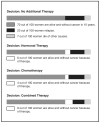Breast cancer patients' treatment expectations after exposure to the decision aid program adjuvant online: the influence of numeracy
- PMID: 20160070
- PMCID: PMC3616375
- DOI: 10.1177/0272989X09360371
Breast cancer patients' treatment expectations after exposure to the decision aid program adjuvant online: the influence of numeracy
Abstract
The decision aid called ''Adjuvant Online'' (Adjuvant! for short) helps breast cancer patients make treatment decisions by providing numerical estimates of treatment efficacy (e.g., 10-y relapse or survival). Studies exploring how patients' numeracy interacts with the estimates provided by Adjuvant! are lacking. Pooling across 2 studies totaling 105 women with estrogen receptor-positive, early-stage breast cancer, the authors explored patients' treatment expectations, perceived benefit from treatments, and confidence of personal benefit from treatments. Patients who were more numerate were more likely to provide estimates of cancer-free survival that matched the estimates provided by Adjuvant! for each treatment option compared with patients with lower numeracy (odds ratios of 1.6 to 2.4). As estimates of treatment efficacy provided by Adjuvant! increased, so did patients' estimates of cancer-free survival (0.37 > r(s) > 0.48) and their perceptions of treatment benefit from hormonal therapy (r(s) = 0.28) and combined therapy (r(s) = 0.27). These relationships were significantly more pronounced for those with higher numeracy, especially for perceived benefit of combined therapy. Results suggest that numeracy influences a patient's ability to interpret numerical estimates of treatment efficacy from decision aids such as Adjuvant!.
Figures




Comment in
-
Adjuvant! And other prediction models in the clinical encounter with cancer patients.Med Decis Making. 2010 Jul-Aug;30(4):422-3. doi: 10.1177/0272989X10375042. Med Decis Making. 2010. PMID: 20634546 No abstract available.
Similar articles
-
The benefits of discussing adjuvant therapies one at a time instead of all at once.Breast Cancer Res Treat. 2011 Aug;129(1):79-87. doi: 10.1007/s10549-010-1193-4. Epub 2010 Oct 14. Breast Cancer Res Treat. 2011. PMID: 20945090 Free PMC article. Clinical Trial.
-
Overview of resistance to systemic therapy in patients with breast cancer.Adv Exp Med Biol. 2007;608:1-22. doi: 10.1007/978-0-387-74039-3_1. Adv Exp Med Biol. 2007. PMID: 17993229 Review.
-
Development of patients' decision aid for older women with stage I breast cancer considering radiotherapy after lumpectomy.Int J Radiat Oncol Biol Phys. 2012 Sep 1;84(1):30-8. doi: 10.1016/j.ijrobp.2011.11.028. Epub 2012 Feb 11. Int J Radiat Oncol Biol Phys. 2012. PMID: 22331002
-
Prospective study of the impact of the Prosigna assay on adjuvant clinical decision-making in unselected patients with estrogen receptor positive, human epidermal growth factor receptor negative, node negative early-stage breast cancer.Curr Med Res Opin. 2015 Jun;31(6):1129-37. doi: 10.1185/03007995.2015.1037730. Epub 2015 Apr 23. Curr Med Res Opin. 2015. PMID: 25851308
-
De-escalating adjuvant therapies in older patients with lower risk estrogen receptor-positive breast cancer treated with breast-conserving surgery: A systematic review and meta-analysis.Cancer Treat Rev. 2021 Sep;99:102254. doi: 10.1016/j.ctrv.2021.102254. Epub 2021 Jun 19. Cancer Treat Rev. 2021. PMID: 34242928
Cited by
-
Approximate Number Processing Skills Contribute to Decision Making Under Objective Risk: Interactions With Executive Functions and Objective Numeracy.Front Psychol. 2018 Jul 13;9:1202. doi: 10.3389/fpsyg.2018.01202. eCollection 2018. Front Psychol. 2018. PMID: 30057562 Free PMC article.
-
Does use of the adjuvant! model influence use of adjuvant therapy through better risk communication?J Natl Compr Canc Netw. 2011 Jul 1;9(7):707-12. doi: 10.6004/jnccn.2011.0061. J Natl Compr Canc Netw. 2011. PMID: 21715722 Free PMC article.
-
The role of ANS acuity and numeracy for the calibration and the coherence of subjective probability judgments.Front Psychol. 2014 Aug 5;5:851. doi: 10.3389/fpsyg.2014.00851. eCollection 2014. Front Psychol. 2014. PMID: 25140163 Free PMC article.
-
How can we best respect patient autonomy in breast cancer treatment decisions?Breast Cancer Manag. 2015;4(1):53-64. doi: 10.2217/bmt.14.47. Breast Cancer Manag. 2015. PMID: 25733982 Free PMC article.
-
Presenting quantitative information about decision outcomes: a risk communication primer for patient decision aid developers.BMC Med Inform Decis Mak. 2013;13 Suppl 2(Suppl 2):S7. doi: 10.1186/1472-6947-13-S2-S7. Epub 2013 Nov 29. BMC Med Inform Decis Mak. 2013. PMID: 24625237 Free PMC article. Review.
References
-
- Studts JL, Abell TD, Roetzer LM, Albers AN, McMasters KM, Chao C. Preferences for different methods of communicating information regarding adjuvant chemotherapy for breast cancer. Psycho-Oncol. 2005;14(8):647–60. - PubMed
-
- Takasugi M, Iwamoto E, Akashi-Tanaka S, Kinoshita T, Fukutomi T, Kubouchi K. General aspects and specific issues of informed consent on breast cancer treatments. Breast Cancer. 2005;12(1):39–44. - PubMed
-
- Woloshin S, Schwartz LM. How can we help people make sense of medical data? Effect Clin Pract. 1999;2(4):176–83. - PubMed
-
- Levine MN, Gafni A, Markham B, MacFarlane D. A bedside decision instrument to elicit a patient’s preference concerning adjuvant chemotherapy for breast cancer. Ann Intern Med. 1992;117(1):53–8. - PubMed
Publication types
MeSH terms
Substances
Grants and funding
LinkOut - more resources
Full Text Sources
Medical
Research Materials

